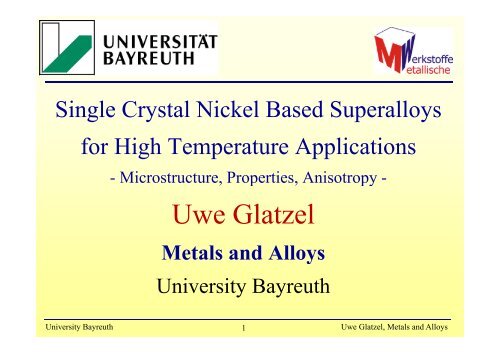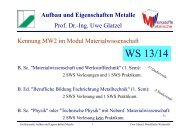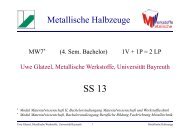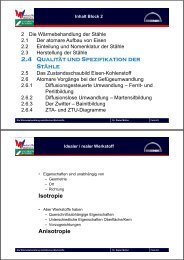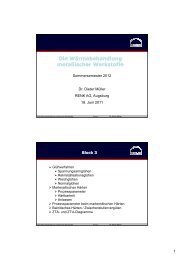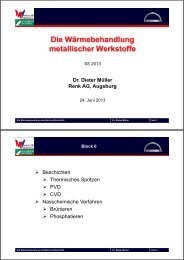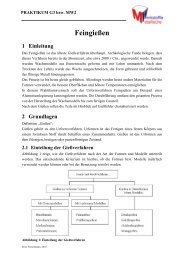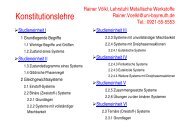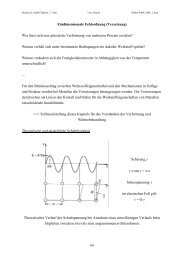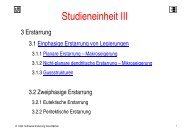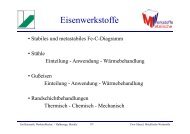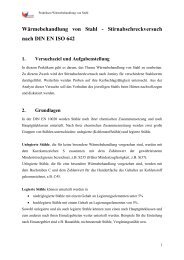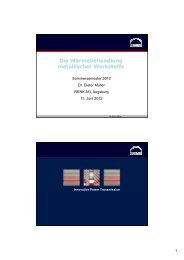Uwe Glatzel
Uwe Glatzel
Uwe Glatzel
You also want an ePaper? Increase the reach of your titles
YUMPU automatically turns print PDFs into web optimized ePapers that Google loves.
Single Crystal Nickel Based Superalloys<br />
for High Temperature Applications<br />
- Microstructure Microstructure, Properties Properties, Anisotropy -<br />
<strong>Uwe</strong> <strong>Glatzel</strong><br />
Metals and Alloys<br />
University yBayreuth y<br />
University Bayreuth <strong>Uwe</strong> <strong>Glatzel</strong>, Metals and Alloys<br />
1
Content<br />
• motivation: history, application field<br />
• processing<br />
• microstructure, misfit<br />
• anisotropic properties<br />
(modulos (modulos, creep behavior)<br />
• dislocations, stress induced diffusion<br />
• Outlook: alloys with reduced density, platinum<br />
based superalloys<br />
University Bayreuth <strong>Uwe</strong> <strong>Glatzel</strong>, Metals and Alloys<br />
2
Superalloys for Extreme<br />
DDemands d<br />
Single crystal nickel based superalloys as material for first<br />
rotating blades after the<br />
combustion chamber in aircraft flight g engines. g<br />
fan<br />
(thrust)<br />
compressor (titanium)<br />
gas temp.: 1500°C<br />
material: 1100°C<br />
20 20.000 000 rpm<br />
⇒ const. stress of<br />
about 100 MPa<br />
(≈ 1 car/cm2 )<br />
University Bayreuth <strong>Uwe</strong> <strong>Glatzel</strong>, Metals and Alloys<br />
3
Model<br />
JetCat P120SX<br />
Flight Model<br />
Rolls Royce RR300<br />
Helicopter<br />
Engine g Alliance<br />
GP 7270<br />
Airbus A380<br />
Examples Turbine Engines<br />
engine g<br />
weight<br />
[kg]<br />
engine power<br />
[kW]<br />
22<br />
14 1.4<br />
(push: 0.13 kN)<br />
disc revolution max. (!) ()<br />
diameter<br />
[m]<br />
speed<br />
[1/min.]<br />
consumption<br />
[l/h]<br />
cost<br />
[1,000 €]<br />
007 0.07 123 123,000 000 ~ 23 28 2.8<br />
80 225 ~ 0.24 50,000 ~ 80 ?<br />
BMW R6 (N52) 161 190 - - 6,000 ~ 65 ~ 6<br />
stationary gas turbine<br />
SGT5-8000H,<br />
Irsching close Munich,<br />
efficiency > 40%<br />
combined cycle > 60%<br />
6,700<br />
444,000<br />
60 60,000 000 take k off ff ~ 18 18,000 000<br />
~ 1.00 12,000<br />
(push: 370 kN)<br />
cruise ~ 3,600<br />
375,000<br />
(c.c.: 570 MW)<br />
~ 4.00 3,000<br />
~ 85,000 heavy<br />
fuel oil<br />
(~ 100,000 m3 /h<br />
gas)<br />
~ 13,000<br />
~ 200,000<br />
University Bayreuth <strong>Uwe</strong> <strong>Glatzel</strong>, Metals and Alloys<br />
4
adius r<br />
[m]<br />
Stress σ at the Foot of the Blade<br />
rotational blade stress<br />
2<br />
speed ω h A<br />
cyc length h σ Fz m⋅ω<br />
⋅ r ρ ⋅h<br />
⋅ A<br />
σ = = =<br />
[1/s] [m] [MPa] A A A<br />
0.035 2,050 0.01 464<br />
2<br />
⋅ω<br />
⋅ r<br />
2 ( ) 2<br />
= ρ ⋅ h⋅ ω ⋅ r = ρ ⋅ h⋅<br />
ω ⋅ ⋅ r<br />
~ 0.12 833 0.03 790 cyc 2π<br />
0.12 833 0.03 790<br />
~ 050 0.50 200 008 0.08 505<br />
ρ≈8 g/cm 3 … material density<br />
F z … centrifugal force<br />
A … area of blade foot<br />
~ 2.00 50 0.25 394 ω … angular speed<br />
maximum, short time stresses!<br />
University Bayreuth <strong>Uwe</strong> <strong>Glatzel</strong>, Metals and Alloys<br />
5
Blade for<br />
stationary<br />
gas turbine bi<br />
for power<br />
production<br />
≈ $ 40 40.000<br />
000<br />
Big Big, Single Crystal Blade<br />
University Bayreuth <strong>Uwe</strong> <strong>Glatzel</strong>, Metals and Alloys<br />
6
η =<br />
max<br />
theor. h<br />
Coefficient of Efficiency<br />
T<br />
regular fuel car engine: < 37%<br />
car diesel engine: < 43%<br />
ship hi di diesel l engine i ( (up tto 900/ 900/min.): i ) < 50%<br />
aircraft turbine: < 40%<br />
stationary gasturbine: < 42%<br />
gas and steam generation: < 60%<br />
Irsching (gas and steam generation): ~ 60%<br />
(gas (g + steam + longg distance heating:~ g 87%) )<br />
max<br />
− T<br />
T<br />
min<br />
min<br />
increase of Tmax increases<br />
coefficient of efficiency<br />
University Bayreuth <strong>Uwe</strong> <strong>Glatzel</strong>, Metals and Alloys<br />
7
[°C]<br />
tempperature<br />
2000<br />
1500<br />
1000<br />
500<br />
Increase in Temperature due to<br />
Improved Construction and Material<br />
polycrystalline<br />
military<br />
civilian<br />
directional solidified<br />
single i l crystal t l<br />
gas temper perature<br />
material tempera perature<br />
improved cooling<br />
improved materials<br />
1950 1960 1970 1980 1990 2000<br />
year<br />
ceramics??<br />
platinum lti<br />
base alloys?<br />
constant<br />
improvement<br />
5-10°C/year<br />
University Bayreuth <strong>Uwe</strong> <strong>Glatzel</strong>, Metals and Alloys<br />
8
floww<br />
stresss<br />
[MPaa]<br />
500<br />
400<br />
Why nickel based superalloys?<br />
Anomalous flow stress behavior of the<br />
intermetallic phase Ni3Al: superalloy heat treated<br />
300 superalloy as cast<br />
200<br />
100<br />
Copley l and dKear,<br />
Trans. AIME<br />
Vol. 239 (1967), 984-992<br />
0<br />
Ni 3 Al<br />
nickel solid solution<br />
0 200 400 600 800 1000<br />
ttemperature t [°C]<br />
70 %<br />
100 %<br />
0 %<br />
University Bayreuth <strong>Uwe</strong> <strong>Glatzel</strong>, Metals and Alloys<br />
9
History yTurbine Engines g<br />
(very strong connected with materials history)<br />
Patents on stationary turbines: 1873 first patent application Franz<br />
Stolze, Berlin "Feuerturbine" (� denied). 1884 Britain first stem<br />
turbine patent granted. Stolze's 2 nd attempt 1897 succesful (same<br />
year in USA). First time running in 1904 with 400°C inlet<br />
temperature.<br />
Commercially<br />
successful<br />
~1930<br />
University Bayreuth <strong>Uwe</strong> <strong>Glatzel</strong>, Metals and Alloys<br />
10
History y Flight g Engines g<br />
(very strong connected with materials history)<br />
• ~ 1930 development of turbine engines for airplanes airplanes.<br />
• 1939 first succesful flight with JUMO 004 on a Me 262 fighter.<br />
Milit Military was not t convinced i dof f bth both airplane i l andd engine. i Bi Big<br />
problems with life time of turbine blades (only ~ 10 h).<br />
First material: TINIDUR Fe Ni30 Cr14 Cr14, then switched to<br />
CROMADUR Fe Cr12 Mn 18 (due to Ni shortage)<br />
JUMO 004<br />
Me 262 replica<br />
University Bayreuth <strong>Uwe</strong> <strong>Glatzel</strong>, Metals and Alloys<br />
11
Recent History Materials<br />
≈ 1980: Inconel 738 (polycrystalline) => 738 LC (single crystal)<br />
50-60vol.% γ' phase, 3wt.% W, 0% Re<br />
SRR 99, CMSX-6 (first generation single crystal)<br />
60-70% γ', 9% W, 0% Re<br />
≈ 1990 1990: CMSX CMSX-4 4( (secondd generation ti SX)<br />
> 70 % γ', 6% W, 3% Re<br />
≈ 1995: CMSX-10 CMSX 10 (third generation SX)<br />
> 70 % γ', 6% W, 6% Re<br />
Costly and time intensive heat treatment:<br />
3-stage homogenization, controlled rapid cooling<br />
2-stage aging<br />
University Bayreuth <strong>Uwe</strong> <strong>Glatzel</strong>, Metals and Alloys<br />
12
Content<br />
• motivation: history, application field<br />
• processing<br />
• microstructure, misfit<br />
• anisotropic properties<br />
(modulos (modulos, creep behavior)<br />
• dislocations, stress induced diffusion<br />
• Outlook (alloys with reduced density, platinum based<br />
superalloys) p y )<br />
University Bayreuth <strong>Uwe</strong> <strong>Glatzel</strong>, Metals and Alloys<br />
13
R = ΔT/Δx<br />
Single Crystal Growing<br />
v = Δx/Δt<br />
alternative: seeding technique<br />
[001]<br />
crystal<br />
direction<br />
R⋅v = ΔT/Δt /<br />
determines the dendrite<br />
spacing i<br />
University Bayreuth <strong>Uwe</strong> <strong>Glatzel</strong>, Metals and Alloys<br />
14
Heat Treatment<br />
example: CMSX-4 standard heat treatment<br />
homogenization:<br />
1h@1280°C 1 h @ 1280 C, 2 h @ 1290 1290°CC, 6 h @ 1300 1300°CC<br />
cooling rate 150-400°C/min.<br />
aging<br />
6 h @ 1140 1140°CC für 6 h, 870 870°CC für 16 h<br />
if possible, possible combined with coating treatment<br />
University Bayreuth <strong>Uwe</strong> <strong>Glatzel</strong>, Metals and Alloys<br />
15
Content<br />
• motivation: history, application field<br />
• processing<br />
• microstructure, misfit<br />
• anisotropic properties<br />
(modulos (modulos, creep behavior)<br />
• dislocations, stress induced diffusion<br />
• Outlook (alloys with reduced density, platinum based<br />
superalloys) p y )<br />
University Bayreuth <strong>Uwe</strong> <strong>Glatzel</strong>, Metals and Alloys<br />
16
Microstructure<br />
ttwo-phase, h single i l crystal: t l<br />
face face-centred-cubic<br />
centred cubic<br />
matrix<br />
(nickel solid solution)<br />
Ni 3Al => fcc, but superlattice<br />
ordering, d i L1 2 or γ' 'Ph Phase di dislocation l ti free<br />
f<br />
University Bayreuth <strong>Uwe</strong> <strong>Glatzel</strong>, Metals and Alloys<br />
17
Ni Ni3Al 3Al ⇔ nickel solid solution<br />
nickel atoms in face centre<br />
aluminium atoms on<br />
cube corners<br />
d Ni3Al = 358,0 pm d nickel solid sol. = 358,7 pm<br />
in nickel solid solution � statistical distribution of atoms<br />
University Bayreuth <strong>Uwe</strong> <strong>Glatzel</strong>, Metals and Alloys<br />
18
Optimal Precipitation Hardening<br />
• round dparticles i l<br />
(better than needle-shaped)<br />
• hi high h volume l fraction f i<br />
• finely dispersed<br />
• small ll particles ti l ( )<br />
• hard precipitates,<br />
soft ft matrix t i<br />
in text books no<br />
information given on<br />
optimum misfit<br />
500 nm<br />
University Bayreuth <strong>Uwe</strong> <strong>Glatzel</strong>, Metals and Alloys<br />
19
Constrained ↔ Unconstrained<br />
Misfit<br />
Small difference in lattice parameter, Δd/d ≈ - (1 – 3)·10 -3<br />
resulting in a coherent interface and internal stresses:<br />
Matrix<br />
isotropic misfit<br />
γ' Phase<br />
Δ d<br />
σ = E ≈100<br />
− 300 MPa<br />
d<br />
Matrix<br />
γ' Phase<br />
misfit high dependent compression stresses of planes in<br />
taken k matrix for f parallel Bragg B to reflection<br />
interface<br />
fl i<br />
University Bayreuth <strong>Uwe</strong> <strong>Glatzel</strong>, Metals and Alloys<br />
20
Two-Phase but 100% Coherent<br />
=> Internal Stresses<br />
University Bayreuth <strong>Uwe</strong> <strong>Glatzel</strong>, Metals and Alloys<br />
21
Stress Distribution<br />
stress<br />
σxx [MPa]<br />
two views of 1/8 of the γ' γ cube with surrounding g<br />
matrix<br />
University Bayreuth <strong>Uwe</strong> <strong>Glatzel</strong>, Metals and Alloys<br />
22
in γ' phase<br />
compression<br />
tension<br />
Stress Distribution<br />
Schematical<br />
in matrix<br />
University Bayreuth <strong>Uwe</strong> <strong>Glatzel</strong>, Metals and Alloys<br />
23
ddendrite d i spacing i<br />
≈ 1/4 mm<br />
single crystal,<br />
bt but no hgomogeneous<br />
h<br />
distribution of tungsten<br />
and rhenium<br />
"Macrostructure"<br />
Macrostructure<br />
[010]<br />
[001]<br />
⇒ therefore local variation of misfit<br />
University Bayreuth <strong>Uwe</strong> <strong>Glatzel</strong>, Metals and Alloys<br />
24
Variation of Misfit due to<br />
Dendritic Segregation<br />
[10 -3 ]<br />
• negative misfit in dendrite<br />
• close to zero in interdendritic region<br />
Völkl, <strong>Glatzel</strong>, Feller-Kniepmeier; Acta mat. 46 (1998) 4395<br />
1<br />
0<br />
-1<br />
-22<br />
-3<br />
-4<br />
-5<br />
Fehlpassung gemessen mit CBED<br />
Neutronenstreuung<br />
Interdendrit Dendrit Interdendrit<br />
University Bayreuth <strong>Uwe</strong> <strong>Glatzel</strong>, Metals and Alloys<br />
25
interdendritic region<br />
Spannnung<br />
[MPPa]<br />
-50<br />
-100<br />
-150<br />
-200<br />
-250<br />
-300 300<br />
Local Stress Variation<br />
dendrite<br />
200 400 600 800<br />
-2.5<br />
-5<br />
-7.5<br />
-10 10<br />
-12.5<br />
up to 300 MPa compression stress<br />
-15<br />
iin matrix t i channels h l in i dendrite d d it<br />
-17.5<br />
spacing i ≈ 250 μm<br />
5 10 15 20<br />
spacing ≈ 0,5 μm<br />
University Bayreuth <strong>Uwe</strong> <strong>Glatzel</strong>, Metals and Alloys<br />
26
Content<br />
• motivation: history, application field<br />
• processing<br />
• microstructure, misfit<br />
• anisotropic properties<br />
(modulos (modulos, creep behavior)<br />
• dislocations, stress induced diffusion<br />
• Outlook (alloys with reduced density, platinum based<br />
superalloys) p y )<br />
University Bayreuth <strong>Uwe</strong> <strong>Glatzel</strong>, Metals and Alloys<br />
27
Elastic Anisotropy together<br />
with ihMi Misfit: fi<br />
�� Explanation for cuboidal γ' precipitates,<br />
with {100} phase boundary planes<br />
�� thereby very high volume fractions<br />
achievable<br />
University Bayreuth <strong>Uwe</strong> <strong>Glatzel</strong>, Metals and Alloys<br />
28
00> [GPa]<br />
E
Creep Deformation<br />
University Bayreuth <strong>Uwe</strong> <strong>Glatzel</strong>, Metals and Alloys<br />
30
High Temperature<br />
Deformation up to 1400°C<br />
temperature<br />
and load are<br />
kept ept co constant sta t<br />
University Bayreuth <strong>Uwe</strong> <strong>Glatzel</strong>, Metals and Alloys<br />
31
l 0<br />
Orientation Dependence<br />
Single crystal with load axis<br />
parallel to [001]<br />
constant load of 500 MPa<br />
(T = 850°C)<br />
"horizontal" / "vertical"<br />
matrix channels<br />
at 850°C<br />
10-6<br />
Strrain<br />
Rate [11/s]<br />
10 -7<br />
10 -8<br />
→ [001] orientation shows best<br />
creep performance<br />
A 2<br />
A 1<br />
C 1<br />
B 2<br />
B 1<br />
+<br />
+<br />
+Fracture<br />
M<br />
CMSX-4<br />
1123K, 500MPa<br />
0 1 2 3<br />
Strain [%]<br />
C1<br />
University Bayreuth 32<br />
<strong>Uwe</strong> <strong>Glatzel</strong>, Metals and Alloys<br />
[111]<br />
M<br />
A 2<br />
B2 B 2<br />
A 1<br />
[001] B 1 [011]
te [s ] -1 strain<br />
rat ]<br />
Orientation Dependence<br />
C<br />
at 980°C<br />
A A<br />
strain<br />
C<br />
anisotropy has less<br />
influence at higher<br />
temperatures<br />
University Bayreuth <strong>Uwe</strong> <strong>Glatzel</strong>, Metals and Alloys<br />
33
Changes in Morphology<br />
980°C, 350 MPa, 28 h<br />
[100]<br />
rafts with planes normal to the<br />
external [001] load axis<br />
σ σ<br />
[001] [110]<br />
[010]<br />
[100]<br />
bars with long axis<br />
parallel to <br />
University Bayreuth <strong>Uwe</strong> <strong>Glatzel</strong>, Metals and Alloys<br />
34<br />
[110]
[001] crystal orientation:<br />
• fastest growing direction +<br />
• elastic soft is good for thermal fatigue +<br />
• elastic soft and misfit leads to {001} phase<br />
boundaries (� cuboidal γ' particles) +<br />
• direction of best creep properties +<br />
University Bayreuth <strong>Uwe</strong> <strong>Glatzel</strong>, Metals and Alloys<br />
35
Content<br />
• motivation: history, application field<br />
• processing<br />
• microstructure, misfit<br />
• anisotropic properties<br />
(modulos (modulos, creep behavior)<br />
• dislocations, stress induced diffusion<br />
• Outlook (alloys with reduced density, platinum based<br />
superalloys) p y )<br />
University Bayreuth <strong>Uwe</strong> <strong>Glatzel</strong>, Metals and Alloys<br />
36
Dislocation configuration<br />
during primary creep<br />
Ph.D. thesis<br />
Th. Link,<br />
TU-Berlin<br />
(1988)<br />
Movement of dislocations<br />
up to 0.5% plastic<br />
deformation mainly in<br />
matrix channels.<br />
University Bayreuth <strong>Uwe</strong> <strong>Glatzel</strong>, Metals and Alloys<br />
37
FEM calculation of stress<br />
di distribution ib i ( (pure elastic) l i )<br />
No external load<br />
� high g compression p stresses in<br />
matrix channels parallel to the<br />
phase boundaries<br />
σ<br />
compression<br />
tension<br />
With an external load (500 MPa)<br />
� high g stress levels in horizontal<br />
channels; low stress levels in<br />
vertical channels<br />
pure elastic at time t = 0<br />
University Bayreuth <strong>Uwe</strong> <strong>Glatzel</strong>, Metals and Alloys<br />
38
tension<br />
FEM calculations of stress distribution<br />
after creep p (plastic (p deformation) )<br />
(Matrix according to Norton creep, γ' phase yields plastisch)<br />
hydrostatic tension p ≈σ ext.<br />
dislocations networks:<br />
horizontaler channel:<br />
High density of edge<br />
dislocations with additional<br />
hlf half plane l within ihiγ' ' phase h<br />
σext. vertical channel:<br />
network of LH- and RH-<br />
screw dislocations,<br />
1/3 density<br />
University Bayreuth <strong>Uwe</strong> <strong>Glatzel</strong>, Metals and Alloys<br />
39
TEM Dislocation Structure:<br />
cross section, ti ε = 21% 2.1 %<br />
external load normal to view plane<br />
50 disl. per cube � ρ≈20⋅10 13 m -2<br />
look onto horizontal matrix<br />
channels, vertical channels edge-on.<br />
longitudinal section<br />
ε = 1 %<br />
10 disl. per cube � ρ ≈ 4⋅1013 m-2 p ρ<br />
University Bayreuth<br />
load axis<br />
40<br />
<strong>Uwe</strong> <strong>Glatzel</strong>, Metals and Alloys
Stress Induced Diffusion<br />
(EDX-TEM)<br />
Large atoms diffuse from vertical to<br />
horizontal channel.<br />
horizontal channel<br />
tungsten<br />
c = 1.<br />
2⋅<br />
σ ext ≈ 500 MPa<br />
ext.<br />
Schmidt and Feller-Kniepmeier, 1993 (SRR99, 760°C)<br />
c<br />
vertical channel<br />
tungsten<br />
University Bayreuth <strong>Uwe</strong> <strong>Glatzel</strong>, Metals and Alloys<br />
41
Summary: Different Strengthening<br />
MMechanisms h i in i Ni-Base Ni B SSuperalloys ll<br />
• It Internal lb back kstress: t σ i = α ⋅ G ⋅ b b⋅<br />
~ 250 MPa ≈ σexternal • Orowan stress:<br />
~ 500 MPa (reduced by coarsening)<br />
• Solid solution strengthening (e.g. by Re):<br />
~110MPa(short range ~1/r2 ~ 110 MPa (short range ~ 1/r )<br />
σ<br />
ρ<br />
Orowan<br />
σ<br />
G ⋅b<br />
≈<br />
L<br />
i<br />
solid solution<br />
• Coherent γ' precipitates: σ coherency ≈ δ ⋅ E<br />
~ -200 MPa (compression, reduced by semi-coherency)<br />
≈<br />
Ω − Ω<br />
Ω<br />
i ci With α =1, G = 100 GPa ≈ E, b = 250 pm, ρ = 1014 m-2 , , p , ρ , L = 50 nm, , c Re = 1 at.%, ,<br />
, δ = -2⋅10-3 Ω<br />
− ΩNi<br />
Re =<br />
Ω<br />
Ni<br />
0.<br />
11<br />
University Bayreuth <strong>Uwe</strong> <strong>Glatzel</strong>, Metals and Alloys<br />
42<br />
E
Summary:<br />
changes h occuring i ddurig i creep<br />
dislocation networks in<br />
phase boundaries<br />
(plastic deformation<br />
according to local<br />
stress distribution)<br />
=> stress induced<br />
diffusion<br />
FEM<br />
+<br />
TEM<br />
W Re Re W Re<br />
TEM<br />
+<br />
EDX<br />
γ'<br />
W<br />
Re<br />
γ'<br />
W<br />
σ ext<br />
TEM +<br />
FEM<br />
=> high hydrostatic stress<br />
level in horizontal channel<br />
+<br />
change in lattice<br />
parameter (misfit). γ'<br />
Change g and<br />
reduction of stress<br />
level.<br />
neutron diffr.<br />
additionally: compostion variation dendrite – interdendritic region<br />
and morphology changes<br />
University Bayreuth 43<br />
<strong>Uwe</strong> <strong>Glatzel</strong>, Metals and Alloys<br />
-
Content<br />
• motivation: history, application field<br />
• processing<br />
• microstructure, misfit<br />
• anisotropic properties<br />
(modulos (modulos, creep behavior)<br />
• dislocations, stress induced diffusion<br />
• Outlook (alloys with reduced density, platinum based<br />
superalloys)<br />
University Bayreuth <strong>Uwe</strong> <strong>Glatzel</strong>, Metals and Alloys<br />
44
Outlook<br />
• International patent (<strong>Glatzel</strong>, Mack, Wöllmer, Wortmann):<br />
Rd Reduce W and dR Re content t t�� reduced d dddensity, it improved i d<br />
phase stability, larger temperature window for solution heat<br />
ttreatment, t t cheaper h �� LEK 94. 94<br />
Within GP 7000 engine for Airbus A 380.<br />
• DFG-Project "Platinbasissuperlegierungen":<br />
Pt-Al-Cr-Ni (+ Ta, + Ti) alloys can copy successful system of nickel<br />
based superalloys (coherent L12 ordered, cuboidal γ' particles with<br />
hi high h volume l fraction f ti embedded b dd d in i fcc-matrix)<br />
f ti )<br />
University Bayreuth <strong>Uwe</strong> <strong>Glatzel</strong>, Metals and Alloys<br />
45
stress [MPa] [<br />
500<br />
230<br />
120<br />
24 K<br />
ΔT = 10 K<br />
LEK 94<br />
10 K<br />
CMSX-6 [Wortmann 88] 8.0 g/cm 3<br />
CMSX-4 [Erickson 94] 8.7 g/cm 3<br />
CMSX-4 [Frasier 90] 8.7 g/cm 3<br />
LEK-2 8.5 g/cm 3<br />
g<br />
LEK-4 8.2 g/cm 3<br />
LEK-5 8.2 g/cm 3<br />
LEK-3 8.1 g/cm 3<br />
LEK-6 83g/cm 3<br />
LEK-6 8.3 g/cm<br />
LEK-1C 8.4 g/cm 3<br />
LEK-1B 8.3 g/cm 3<br />
LEK-1A 8.2 g/cm 3<br />
29 K<br />
25 26 27 28 29 30 31 32<br />
Larsen-Miller-Parameter<br />
Larsen Miller Parameter<br />
P = (T+273) [20+log tB ] 10 -3<br />
not corrected with<br />
density! y<br />
Patente: D, Europa, USA, Kanada, Japan<br />
University Bayreuth <strong>Uwe</strong> <strong>Glatzel</strong>, Metals and Alloys<br />
46
PPt 77Al Al14Cr C 6Ni Ni6<br />
12h @1500°C +<br />
120h @1000°C<br />
CMSX-4,<br />
same<br />
magnification<br />
Microstructure<br />
Platinum Based Superalloy<br />
Hüller et al., Met.Mat.Trans. A, 36A (2005), 681<br />
University Bayreuth <strong>Uwe</strong> <strong>Glatzel</strong>, Metals and Alloys<br />
47
Misfit<br />
Platinum Based Superalloys<br />
Pt84Al 84 11Cr 11 3Ni 3 2<br />
Pt 80Al 11Cr 3Ni 6<br />
Pt 77Al 10Cr 3Ni 10<br />
University Bayreuth <strong>Uwe</strong> <strong>Glatzel</strong>, Metals and Alloys<br />
48
Stress<br />
1000<br />
100<br />
Creep Properties<br />
Platinum Based Superalloys<br />
CMSX-4 (single crystal !)<br />
Maximum Stress in<br />
Compression with<br />
-5 -1<br />
St Strain i Rate R t 10 5 s 1<br />
γ' precipitate dissolution<br />
in Ni-base alloys<br />
γ' precipitate dissolution<br />
in Pt-base alloys<br />
Pt82Al7Cr6+Ta5<br />
Pt82Al7C Pt82Al7Cr6+Ti5 6+Ti5<br />
Pt77Al12Cr6+Ni5<br />
Pt77Al12Cr6+Fe5<br />
Pt77Al12Cr6+Co5<br />
10<br />
700 800 900 1000 1100 1200 1300 1400<br />
Temperature [°C]<br />
University Bayreuth <strong>Uwe</strong> <strong>Glatzel</strong>, Metals and Alloys<br />
49
University Bayreuth <strong>Uwe</strong> <strong>Glatzel</strong>, Metals and Alloys<br />
50


